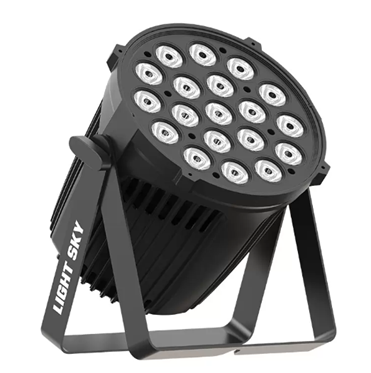What Wattage (Lumens) or Size of LED Par Light Is Right for My Project?
Choosing the right LED PAR light can be a complex task, often muddled by ambiguous specifications.
A primary source of confusion lies in equating wattage with light output, whereas lumens are the accurate measure of brightness. Furthermore, misunderstanding beam angle and spread can result in lights that are either too weak for adequate coverage, excessively powerful for the intended area, or have an inappropriate distribution, failing to achieve the desired illumination, or creating unwanted effects.
The market also presents challenges with varying quality, impacting crucial aspects like color rendering, dimming capabilities, and overall lifespan, ultimately increasing the risk of investing in a light ill-suited for the specific job. If you are overwhelmed by these, then this guide gives you some hints on choosing the right LED PAR lights.
Wattage, Lumens, and PAR “Sizes” Explained
Do they all represent the “brightness”, not exactly? Here is the detailed explanation:
Wattage or Lumens?
In recent years, LED technology has swept the industry, generally replacing the old incandescent light as the mainstream, considering the greater illuminate efficiency compared to the incandescent one of the same wattage.
To speak frankly, an LED PAR light of, say, 50 watts can easily outshine an incandescent PAR of 500 watts, while consuming a fraction of the power and generating less heat.
In this way, Lumens emerged as the standardized, universal measure of a light source’s total perceived brightness. A higher lumen rating directly translates to more light reaching your stage or surface, regardless of the power consumed.
Here is the Lumens to Watts calculator that can help you estimate the LED PAR or other stage lighting fixtures you need:
“Size” of PARs: PAR Can Numbers Explained
Have you found PAR38, PAR56, or PAR64 on the spec?
These numbers refer to the traditional diameter of the PAR (Parabolic Aluminized Reflector) lamp itself, measured in eighths of an inch.
Essentially, a higher number indicates a larger lamp or fixture head, which typically implies a larger light-emitting surface and often, though not always, a higher potential light output and throw distance.
Here’s what these numbers generally mean:
How Many LED PAR Lights Do You Really Need?
Calculating the right number of LED PAR lights for your project is about brightness; it’s about optimizing coverage, impact, and efficiency for the specific environment:
Small DJ Setup / Band in a Bar
For intimate performances or smaller venues, the goal is often to create ambiance, highlight performers, and add dynamic color. Over-lighting can be as detrimental as under-lighting.
For a 15×20 ft (4.5×6 m) performance area in a bar or small club:
Recommendation:
- 4-6 x 60W-100W LED PARs (2,000-3,500 lumens each): These provide ample light for general stage washing and color changes. Look for RGB LED or RGBA fixtures for versatile color mixing.
- Beam Angle: Aim for a medium beam angle (25°-40°) for a good balance of coverage and intensity.
- Placement: Two to three fixtures positioned on the front truss or uprights for front wash, and two to three on the floor or rear truss for backlighting and uplighting.
What PAR You Should Pick: MAMBA & PL1915


Church / School Stage
It should be more performer-prioritized, natural-looking light, smooth transitions, and reliable performance are paramount. The layout should feature comprehensive front wash, backlighting, and accent lighting, with an emphasis on good white light rendition and subtle color. For a 30×40 ft (9×12 m) medium-sized stage and altar area:
Recommendation:
- 8-12 x 100W-150W LED PARs (3,500-6,000 lumens each): This provides robust coverage and brightness for various events.
- Beam Angle: A mix of medium (30°-45°) for general wash and narrower (20°-30°) for accenting lecterns or soloists.
- Color Configuration: RGBW LED PARs are highly recommended here. The dedicated white LED ensures excellent skin tones and clear, natural-looking illumination for speakers, while the RGB allows for mood-setting and special event lighting (e.g., a subtle green and red color mix for holiday services).
- Placement: Four to six fixtures on a front truss for key and fill light, ensuring even illumination of faces. Four to six fixtures on the rear truss or the floor for backlighting, separation, and creating depth. Two to four additional fixtures can be used for side light or architectural uplighting.
What PAR You Should Pick:
Event Uplighting / Architectural Accent
Uplighting transforms spaces, adding depth, color, and visual interest to walls, pillars, and structural features. The place requires even, consistent washes of color or static white light, with robust, often battery-powered, and weather-resistant options.
For a 50×80 ft (15×24 m) ballroom or event space requiring full perimeter uplighting and accentuation of specific features:
Recommendation:
- 20-40 x 10W-30W LED PARs (1,000-2,500 lumens each): While individual lumen output may be lower, the sheer number of fixtures creates a powerful cumulative effect.
- Beam Angle: Primarily wide beam angles (45°-60°+) to achieve broad, even washes on surfaces.
- IP Rating: Crucially, many uplighting scenarios occur outdoors or near drink spills, so IP65-rated LED PARs are often essential for durability and safety.
- Color Configuration: RGBWA+UV LED options are popular for maximum versatility, allowing for a vast color palette including pastels, deep saturated tones, and UV glow effects.
- Placement: Spaced evenly around the perimeter of the room, typically 5-10 feet apart, aimed upwards at walls, columns, or architectural details. Additional units for specific focal points.
What PAR You Should Pick: PL1915-HC

LiGHT SKY Says: Your Trust Matters
Now that you know how to choose the PAR that features the utmost illumination effect, don’t forget that the quality is the basis that will influence the performance consistency and lifespan. Therefore, where to buy the stage lighting fixtures is important.
At LiGHT SKY, we understand these challenges intimately. Our commitment extends beyond just meeting technical specifications; we focus on engineering professional stage lighting solutions that will not let you down.
So, no more waiting, let’s amaze the audience.









